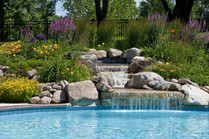Lawn Tips
March: If you haven't already done so, you need to remove all debris from your yard (such as leaves, twigs, etc.)
After all debris has been removed, if you have an excess buildup of thatch, you should de-thatch your yard. After this process, the next step to a beautiful green lawn is core aeration. This step bores holes in the ground towards the grass root system to allow air and spring rain to enter the grass root system and accelerate growth.
Late March: This is the time of year to lime and fertilize. A pH test will help you determine the amount of lime needed for a balanced soil. Fertilize according to the needs of your lawn (i.e. weed and feed type fertilizer if you have an abundance of weeds already present; starter fertilizer for a new lawn; 10-10-10 for an established healthy lawn, etc.)
April-May: The first few cuttings should be short (2 to 2-1/2 inches) to ensure all dead grass is removed. During this time of the year frequent cuttings (on a weekly basis) help encourage root growth and thus a healthier lawn.
June-August: During the hotter months of the year, raise the height of the cut (3 to 3-1/2 inches) to ensure the ground is shaded to maintain moisture in the roots. This should promote deeper root growth.
September: This is the perfect time of the year to core aerate the yard one more time. This step bores holes in the ground towards the grass root system to allow air and rain to enter the grass root system and accelerate growth. After you aerate, you can apply fertilizer and seed your lawn to get a good start on your new grass growth before the first frost of the year.
Fall: Leaf removal season! To keep your grass healthy, remove the leaves so that they don't kill new growth.








